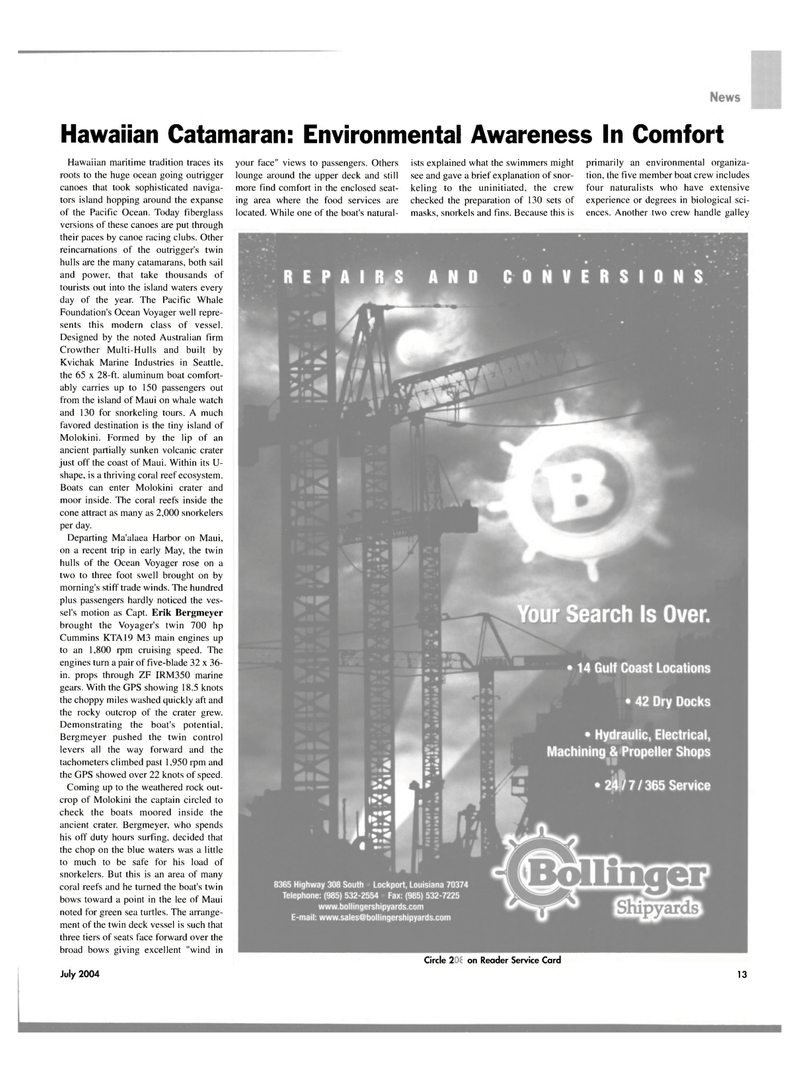
Page 13: of Maritime Reporter Magazine (July 2004)
Gulf of Mexico: Floating Production Systems & Support Vessels
Read this page in Pdf, Flash or Html5 edition of July 2004 Maritime Reporter Magazine
Hawaiian Catamaran: Environmental Awareness In Comfort
Hawaiian maritime tradition traces its roots to the huge ocean going outrigger canoes that took sophisticated naviga- tors island hopping around the expanse of the Pacific Ocean. Today fiberglass versions of these canoes are put through their paces by canoe racing clubs. Other reincarnations of the outrigger's twin hulls are the many catamarans, both sail and power, that take thousands of tourists out into the island waters every day of the year. The Pacific Whale
Foundation's Ocean Voyager well repre- sents this modern class of vessel.
Designed by the noted Australian firm
Crowther Multi-Hulls and built by
Kvichak Marine Industries in Seattle, the 65 x 28-ft. aluminum boat comfort- ably carries up to 150 passengers out from the island of Maui on whale watch and 130 for snorkeling tours. A much favored destination is the tiny island of
Molokini. Formed by the lip of an ancient partially sunken volcanic crater just off the coast of Maui. Within its U- shape, is a thriving coral reef ecosystem.
Boats can enter Molokini crater and moor inside. The coral reefs inside the cone attract as many as 2,000 snorkelers per day.
Departing Ma'alaea Harbor on Maui, on a recent trip in early May, the twin hulls of the Ocean Voyager rose on a two to three foot swell brought on by morning's stiff trade winds. The hundred plus passengers hardly noticed the ves- sel's motion as Capt. Erik Bergmeyer brought the Voyager's twin 700 hp
Cummins KTA19 M3 main engines up to an 1,800 rpm cruising speed. The engines turn a pair of five-blade 32 x 36- in. props through ZF IRM350 marine gears. With the GPS showing 18.5 knots the choppy miles washed quickly aft and the rocky outcrop of the crater grew.
Demonstrating the boat's potential,
Bergmeyer pushed the twin control levers all the way forward and the tachometers climbed past 1,950 rpm and the GPS showed over 22 knots of speed.
Coming up to the weathered rock out- crop of Molokini the captain circled to check the boats moored inside the ancient crater. Bergmeyer, who spends his off duty hours surfing, decided that the chop on the blue waters was a little to much to be safe for his load of snorkelers. But this is an area of many coral reefs and he turned the boat's twin bows toward a point in the lee of Maui noted for green sea turtles. The arrange- ment of the twin deck vessel is such that three tiers of seats face forward over the broad bows giving excellent "wind in
July 2004 your face" views to passengers. Others lounge around the upper deck and still more find comfort in the enclosed seat- ing area where the food services are located. While one of the boat's natural- ists explained what the swimmers might see and gave a brief explanation of snor- keling to the uninitiated, the crew checked the preparation of 130 sets of masks, snorkels and fins. Because this is primarily an environmental organiza- tion, the five member boat crew includes four naturalists who have extensive experience or degrees in biological sci- ences. Another two crew handle galley
Circle 265 on Reader Service Card 13

 12
12

 14
14
